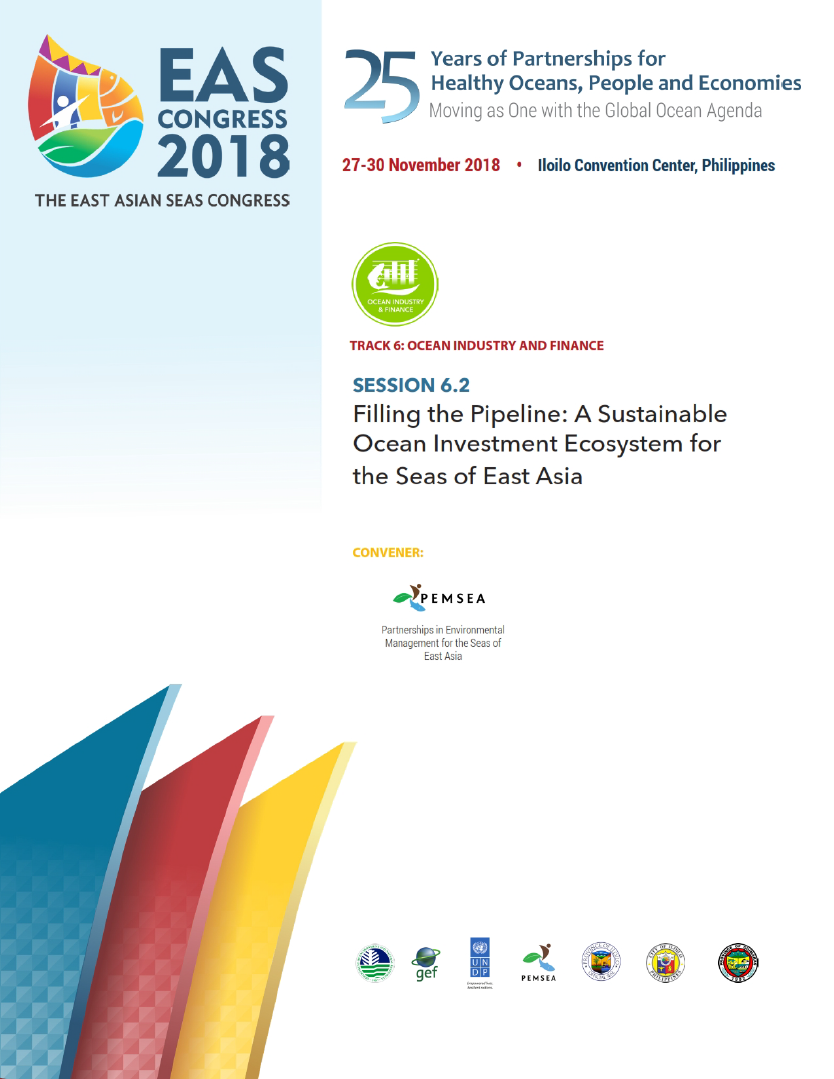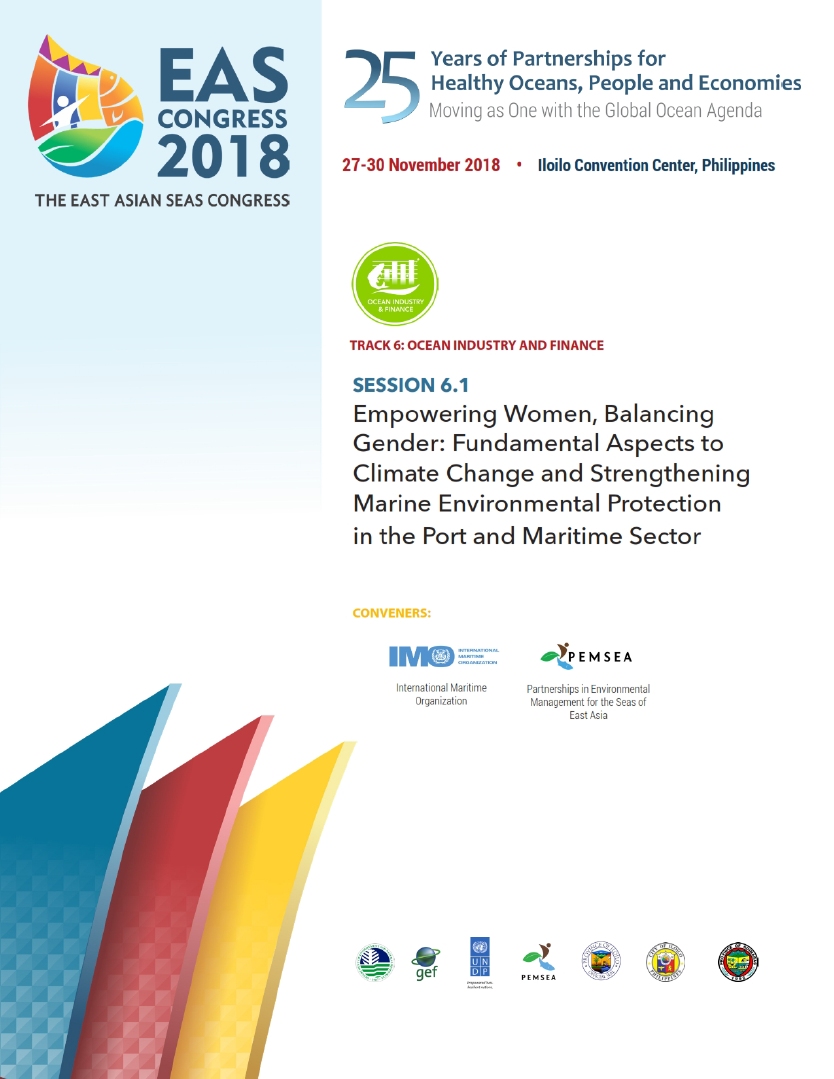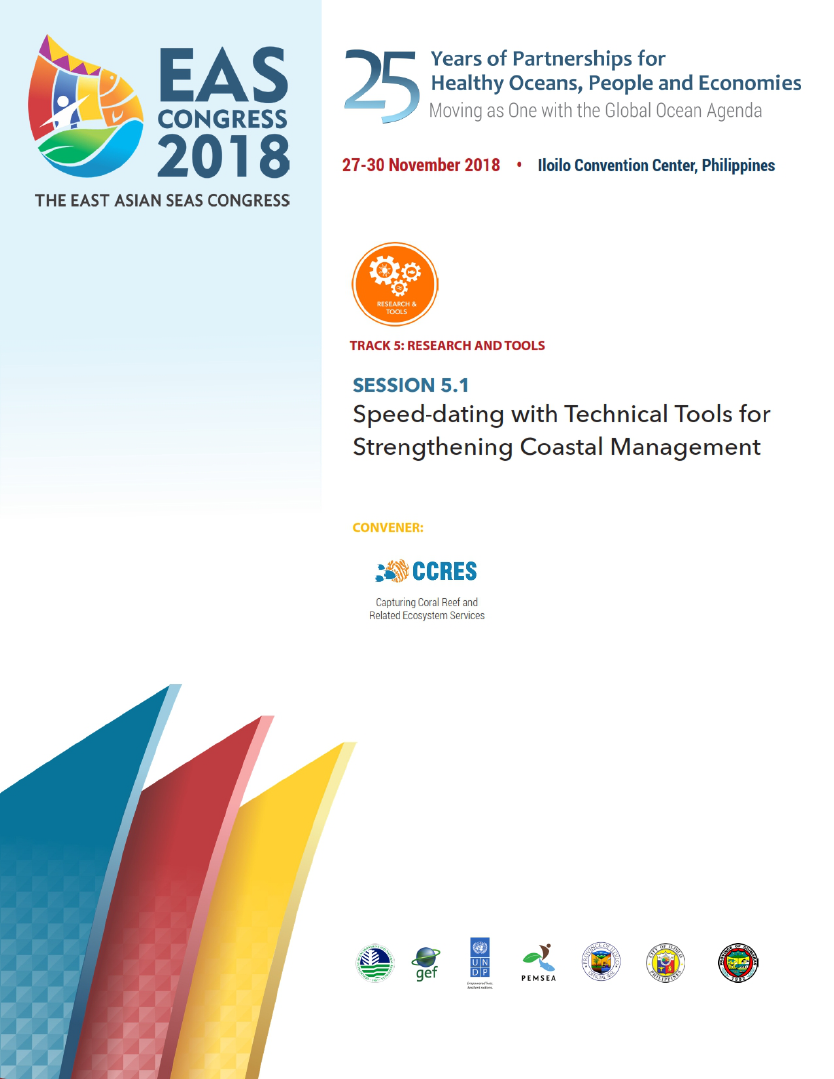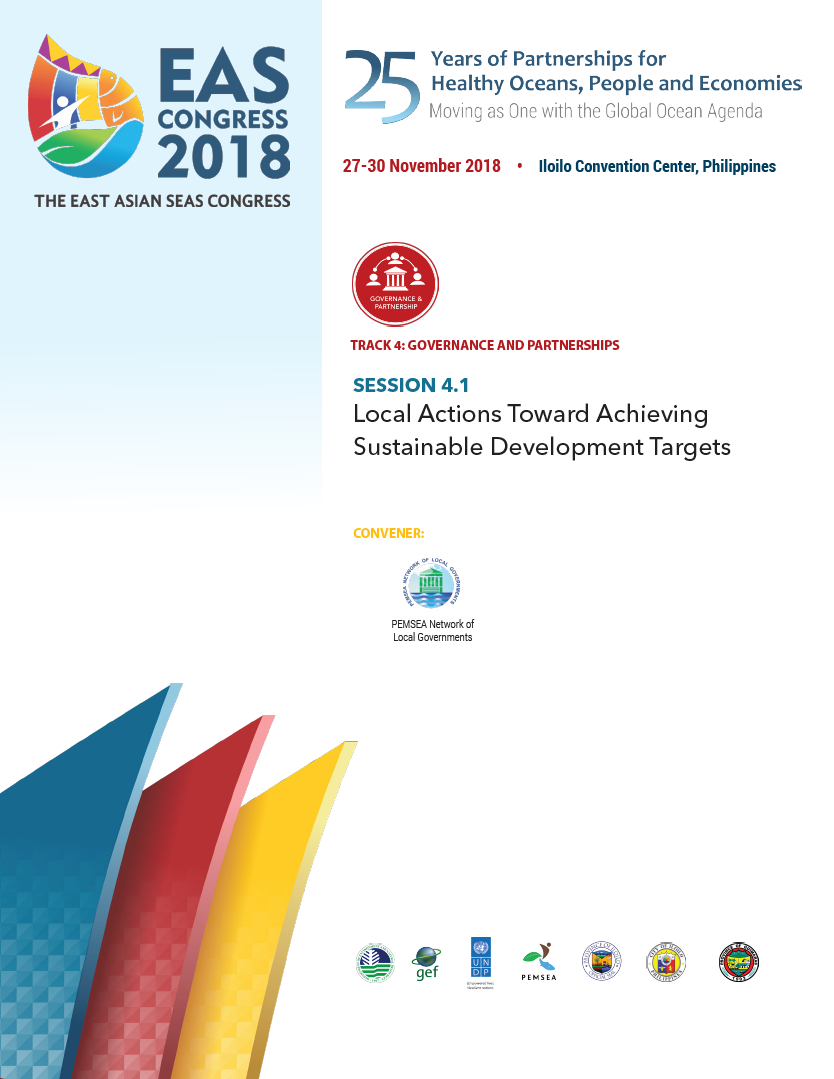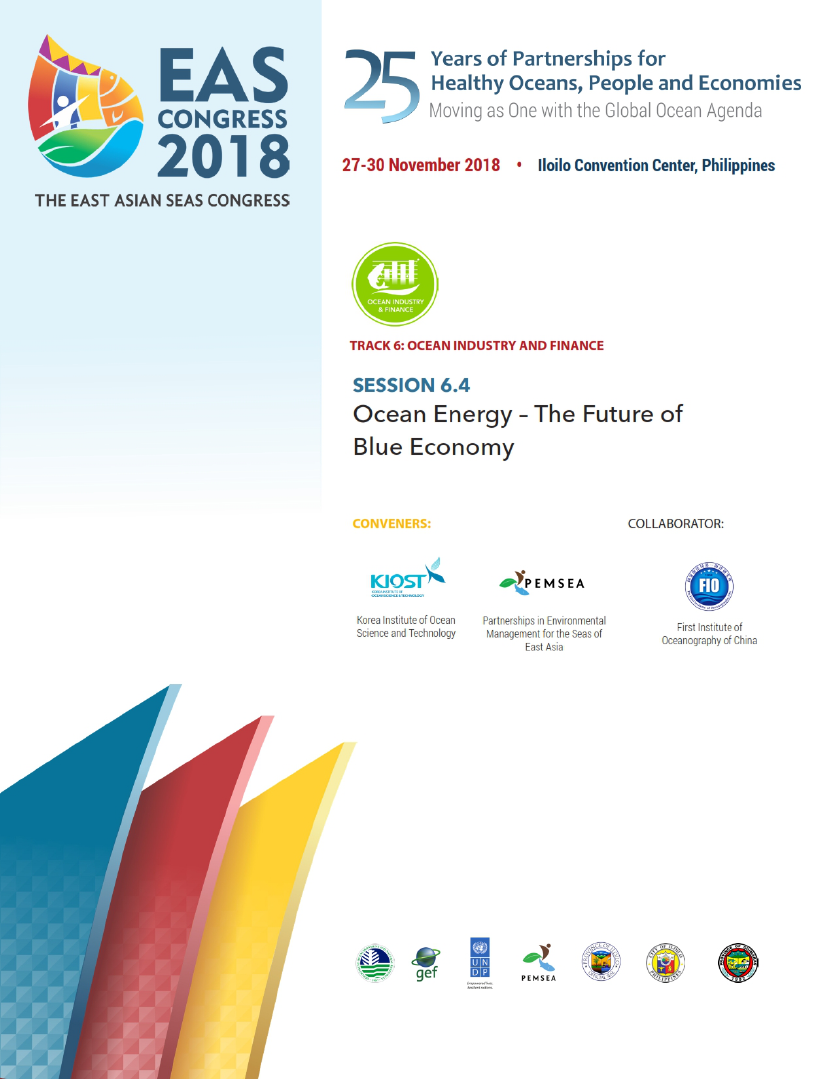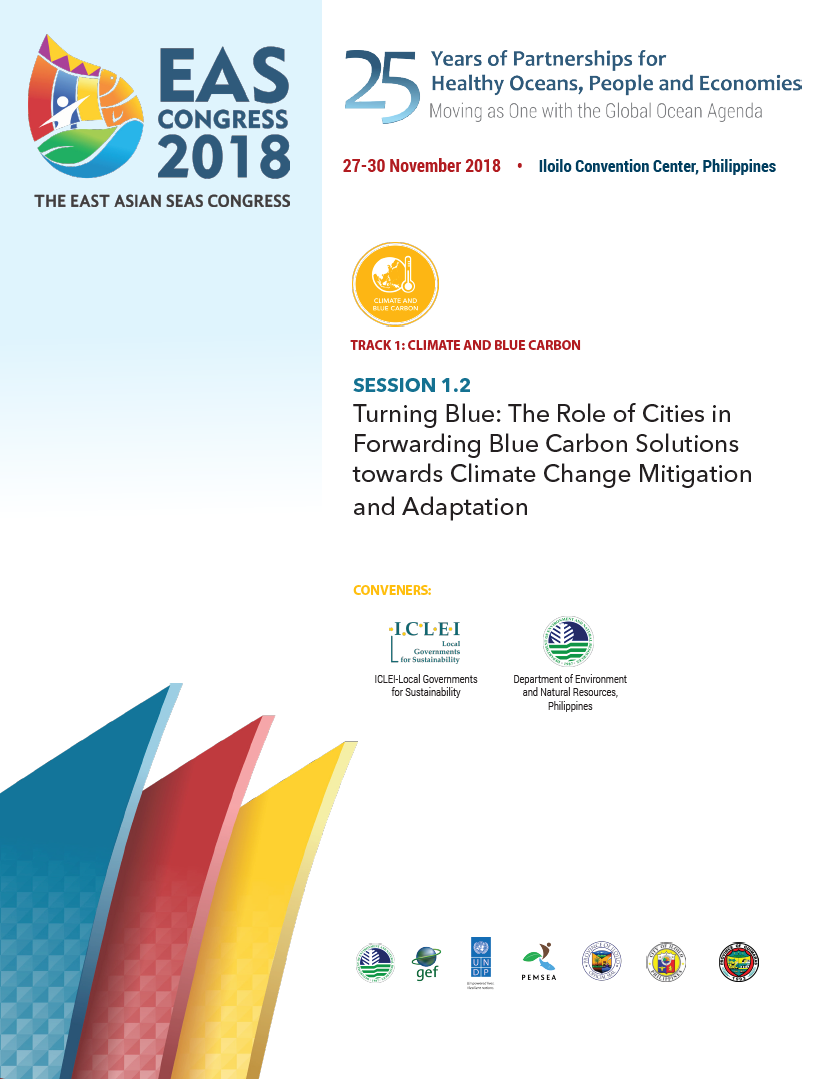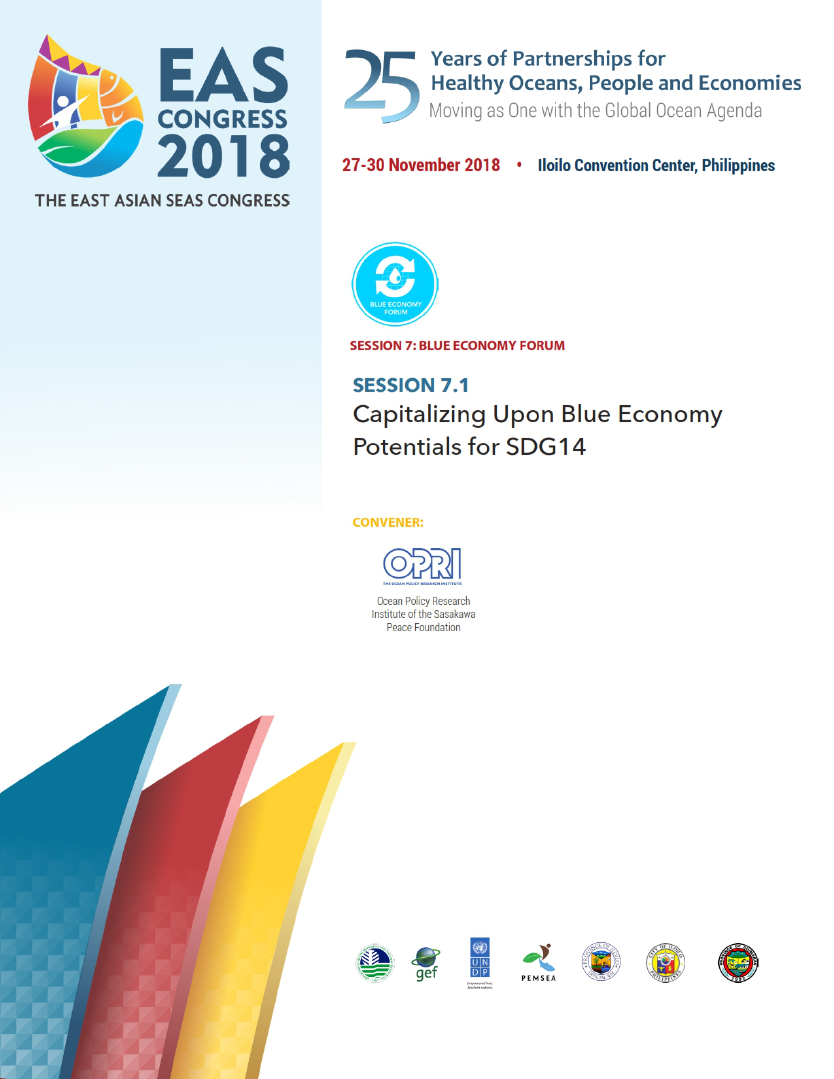
Breadcrumb
Proceedings of the workshop on Filling the Pipeline: A Sustainable Ocean Investment Ecosystem for the Seas of East Asia (EASC2018 Session 6 Workshop 2)
The need for significantly increased investment to achieve the targets under the UN Sustainable Development Goals (SDGs) is well understood. UNDP cites a USD2.5 trillion gap in investments required to meet the SDGs, and it’s not likely that all of this financing will come from government and donor support. By catalyzing private sector investment, there is an opportunity to redirect billions of dollars of capital away from unsustainable investment towards sustainable, blue economy investments in the region.
To address this need and opportunity, a number of new funds have emerged to focus on investing in sustainable development of oceans, in areas including fisheries, marine pollution and coastal tourism. However, funds face challenges in sourcing investment projects that can support the SDGs while offering viable investment models. Local governments look to engage in the investment conversation, but may not know where to start. At the same time, donor support has a role to play in developing new models and approaches that can lower risks and catalyze the flow of private capital to investments that can have an impact at the local level.
This session was designed to introduce the emerging investment ecosystem for the Seas of East Asia, including lessons learned for sourcing and developing investments that address critical ocean challenges, such as ocean plastics, wastewater, sustainable aquaculture, marine conservation, and more. Building on the regional Strategic Action Programme (SAP) coordinated by PEMSEA, which brings together donors, technical partners and the private sector, this new investment ecosystem can catalyze both public and private financing, building a pipeline of investment opportunities supporting SDG 14 and unlocking the ocean investment potential in region.
Proceedings of the workshop on Empowering Women, Balancing Gender: Fundamental Aspects of Adapting to Climate Change and Strengthening Marine Environmental Protection in the Port and Maritime Sector (EASC2018 Session 6 Workshop 1)
This partnership hub aimed to identify and review existing programmes and initiatives on strengthening the integration of women and gender equality in the port and maritime sector. International organizations in this sector (e.g. IMO, ILO) are encouraging countries to enable women to train alongside men to acquire the high-level of competence that the port and maritime industry demands to better cope with the demands of the jobs, including the effects of climate change.
How are the national maritime agencies and training institutes proceeding? The partnership hub aimed to review the progress among East Asian countries, particularly in the context of two key challenges to sustainable port management and operations, namely: climate risk assessment, mitigation and adaptation; and marine environmental protection in the port sector. The application of the Port Safety, Health and Environmental Management System (PSHEMS) as a framework for facilitating the planning, development implementation of women and gender safeguards in the port industry will also be explored.
The partnership hub also aimed to consider how national agencies and training institutes in the maritime and port sector can be encouraged and assisted to adopt and implement programs on empowering women and gender equality, and to strengthen these aspects in future trainings on PSHEMS and management interventions focused on climate change and marine environmental protection.
Proceedings of the workshop on Speed-dating with Technical Tools for Strengthening Coastal Management (EASC2018 Session 5 Workshop 1)
In developing countries, coastal ecosystems — coral reefs, mangroves and seagrass beds — provide fish to eat and trade, support tourism, protect coastlines from storms and filter water. Coastal communities rely on these coastal ecosystems for their livelihoods, food and wellbeing. Unfortunately, these ecosystems are under threat from pollution, overfishing, destructive fishing, unsustainable coastal development and climate change.
The Capturing Coral Reef & Related Ecosystem Services (CCRES) project (2014-2018) has been assisting governments and communities to sustain these coastal ecosystems. In collaboration with project partners and beneficiaries, the CCRES project has developed a suite of technical models, tools and knowledge products to assist managers, policymakers and planners to strengthen the governance of coastal ecosystems.
The tools are used for planning Marine Protected Areas (MPAs), modelling socioecological systems, developing sustainable enterprises and fostering behaviour change. They have been developed following research by multi-disciplinary teams that include scientists, policy-makers, businesses and other experts from a range of fields — collaboration between centres of discovery, learning and engagement in North America, Australia and importantly our partners in Indonesia and the Philippines.
In this session attendees joined fun, interactive “speed-dating” groups, facilitated by experienced CCRES team members. The session “matched” tools with 24 participants and explored how together they can strengthen integrated coastal management, planning and governance across the East Asian Seas region.
Proceedings of the workshop on Local Actions Toward Achieving Sustainable Development Targets (EASC2018 Session 4 Workshop 1)
The PEMSEA Network of Local Governments (PNLG) adopted the Ansan Declaration on 6 September 2016 in Ansan, Republic of Korea, which renewed the commitment of the members to implement the PNLG Strategic Action Plan (2016-2021) through their respective integrated coastal management (ICM) programs and related initiatives. The local governments committed, in particular, to identifying time-bound SDG targets and plans for sustainable development of coastal areas and blue economy growth; report annually on the progress towards achieving the targets and share information through various knowledge platforms.
This session provided the opportunity for the PNLG members and other local governments and partners to discuss the experiences and good practices in implementing plans and programs related to SDG 6 (water and sanitation), SDG 11 (sustainable cities), SDG 13 (climate action), SDG 14 (Life below water and SDG 17 (partnerships for the goals). The session also discussed the mechanisms for implementation, monitoring and reporting and partnership development in facilitating the achievement of the SDG targets at the local level.
Proceedings of the workshop on Ocean Energy — The Future of Blue Economy (EASC2018 Session 6 Workshop 4)
Ocean is the biggest carbon sink of the earth system which sequestrate more than 2 billion metric ton per year or one third of anthropogenic carbon generation. Ocean possesses not only the sequestrating potential but also the power to produce renewable energies which ultimately contribute to the reduction of fossil fuel consumption. Owing to its enormous potent energy through tide, wave, heat and others, the oceans provide numerous opportunities for energy sources which fuel necessary economic development in the era of climate change afflicted global community.
The status of ocean energy development is in its nascent stage. Research efforts have been devoted to the development of key technological components with certain degree of successes. However, there are myriad of works need to be done before ocean energy can be mainstreamed into the power sector. Barriers such as non-supportive government policies and resistance to clean and renewable energy sources by the Business As Usual (BAU) energy sectors make ocean energy development sluggish.
In this workshop, the success stories of the ocean energy development as well as up to date government policies will be presented in support of the ocean energy development around the globe. The case studies in the East Asian Seas region will be highlighted. The roles and contributions of ocean energy in the Blue Economy will also be delved into.
Proceedings of the workshop on Turning Blue: The Role of Cities in Forwarding Blue Carbon Solutions towards Climate Change Mitigation and Adaptation (EASC2018 Session 1 Workshop 2)
Attended by at least 42 participants representing local government units, national government agencies, academe, private sector, local communities, and other key stakeholder groups, the session aimed to revisit the important role that local governments play in designing and implementing innovative blue carbon solutions. The activity became a venue to discuss and share strategies and programs towards integrated marine resource management.
Fostering an interactive and dynamic interaction amongst the participants, the session employed the Marketplace Activity approach. The resource speakers presented posters highlighting the blue carbon solutions that they are implementing in their respective localities. To enable the participants to directly engage and discuss with the speakers, the plenary was divided into groups and each group was given the chance to visit each poster station. As a culminating activity, the resource speakers and the participants gathered for a panel discussion that summarized the highlights of the session. The panel discussion was also a venue for the participants to express additional questions, insights, ideas, and other pertinent feedback related to the topic of the session.
Key learnings from the workshop centered on recognizing the importance of community participation. The resource speakers noted that local governments should always encourage and solicit the engagement and cooperation of its stakeholders, particularly the local communities who can be tapped as stewards of the marine ecosystems. In addition, the session also put premium on the enforcement of the laws and policies in place. The participants and the speakers agree that ordinances pertaining to fishing activities, harvesting of marine resource, pollution, and others should be strictly enforced at all times. The local government should allocate resources to support the operations of local enforcement groups such as the Bantay Dagat.
Another theme of the discussions is linkages and partnership building. Recognizing that the effects of climate change know no boundaries, the local governments maintained that partnership building with neighboring municipalities, national agencies, academe, private sector, and others is a strategic approach to integrated marine resource management. Inter-LGU cooperation and networking also scales up blue carbon solutions and allows them to pool their resources to expand the coverage of their initiative. A good example for this is the Oriental Mindoro Marine Protected Area (MPA) Network, a province-wide effort to uphold and preserve the biophysical integrity of the seas of Oriental Mindoro.
As a knowledge sharing session, the participants and the resource speakers also discussed key points and considerations for replication of the presented strategies. The resource speakers noted that municipalities should assess their challenges, context, and priorities first before they design their own blue carbon initiatives.
Proceedings of the workshop onLarge Marine Ecosystems: An engine for achieving SDG 14 (EASC2018 Session 4 Workshop 4)
In 1995, the Global Environment Facility adopted the concept of Large Marine Ecosystems (LMEs) — the majority of which are transboundary — as a conceptual and biogeographic framework for promoting sustainable, ecosystem-based management of the world’s oceans and coasts. The LME approach promotes the creation of new and/or reformed institutions, the reform and implementation of marine resource and environmental management policies and legislation, and the leveraging of public and private sector investment for LME restoration and protection. At a regional scale, the GEF has supported 23 of the 66 recognized Large Marine Ecosystems in which multiple countries collaborate on strategic, long-term ocean governance of transboundary resources.
The Yellow Sea, South China Sea, East China Sea, Sulu-Celebes, Indonesian Sea, Bay of Bengal and Gulf of Thailand are seven LMEs of great ecological and economic importance to the region. The relationships developed through shared project implementation and coordination enables various LME partnerships to help countries incorporate the various SDG14 targets into existing dialogue and policy. Moreover, the forum provided by LMEs encourages important dialogues, emphasizes the exchange of experience and results, provides a focus to scale up existing investments, and catalysis resources towards the achievement of SDG14 targets.
Drawing on the LME experience, this partnership hub not only offered a brief introduction to the Asian LME portfolio in the context of SDG14, but more importantly it highlighted proven approaches that have succeeded in reversing and reducing impacts using integrated ecosystem-based approaches to sustainable ocean and coastal management at both a local and multi-country scale.
Proceedings of the workshop on Capitalizing Upon Blue Economy Potentials for Achieving SDG 14 (EASC2018 Session 7 Workshop 1)
The Ocean Policy Research Institute of the Sasakawa Peace Foundation (OPRI-SPF) convened a Partnership Hub track 7 Session 1 entitled “Capitalizing upon Blue Economy Potentials for Achieving SDG14” at Conference Room 7 from 13:30-17:30 on Wednesday 27 November 2019.
Proceedings of the workshop on Catalyzing Improved Source-to-Sea (S2S) Governance, Management and Investment in East Asia and Southeast Asia (EASC2018 Session 2 Workshop 4)
Ecosystems along a continuum from source-to-sea are being degraded as an unintended consequence of economic activities that might happen far upstream or downstream in the source-to-sea system (Granit. J. et al, 2017). This is happening primarily for two reasons: 1) lack of awareness and understanding of the land-to-sea ecosystem linkages and flows of water, sediment, pollutants, biota and ecosystem services; and 2) lack of capacity and know-how to avoid or mitigate the interconnected threats and negative impacts coming from multiple sectors and multiple resource users. The impacts of climate change currently add further stresses in river basins and coastal and sea areas in most regions of the world. It is clearly evident that the UN Sustainable Development Goals (SDG) include a number of targets (e.g., SDG 2, 6, 8, 11, 12, 13, 14 and15) that are directly dependent upon the ability of governments and their partners to overcome these barriers.
A related overarching concern is that water use among East Asian and Southeast Asian countries is growing rapidly, while water quality and quantity challenges persist in such a way that the situation in some areas has threatened to derail economic growth. Increased population has intensified freshwater usage, both surface and ground water. Water demand is increasing drastically due to rapid urbanization, industrialization and agriculture/food production intensification and expansion, and many areas in the region are projected to be water stressed by 2025 (Lee 2013).
These two issues are inseparably linked and require urgent attention.
The S2S Partnership Hub Dialogue session aimed to:
- enhance S2S awareness by sharing the experiences and perspectives of policymakers, managers and practitioners at the regional, national and local levels;
- identify priority demands, opportunities and challenges for further development and up-scaling of S2S solutions across the region;
- explore and gather inputs on a regional approach to S2S, including potential value-add, focus areas, content, partners, etc. and, in doing so, confirm interest and informal endorsement of next steps.
- enhance S2S awareness by sharing the experiences and perspectives of policymakers, managers and practitioners at the regional, national and local levels;
